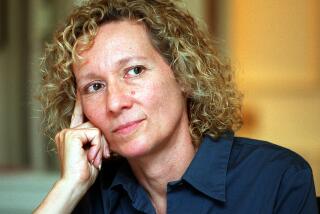Barbara Willis dies at 94; California ceramist
Nearly 40 years after she had stopped producing pottery, Barbara Willis made a startling discovery at a Long Beach flea market in 1995. Without her knowledge, she had become a highly collectible artist.
After she pointed to a vase and said, “I made that,” she learned that her vibrantly colored, crackle-glaze pottery from the 1940s and ‘50s was in demand. Collectors had been searching for her for years.
Prodded by fans, Willis re-started her career as a ceramist when she was in her late 70s, hand-molding pieces in her Malibu kitchen. The first time around, she was among the first to adapt studio techniques to commercial pottery, using molds to mass produce simple geometric wares that had a hand-made look.
Willis died Sept. 3 of natural causes at her home in San Ramon, Calif., said her daughter, Liz Graham. She was 94.
“She was a really important figure in the commercial pottery scene in California,” said Bill Stern, executive director of the Museum of California Design. “She also was one of the first of what we now call Midcentury Modern designers in California.”
“Barbara set out to make pottery that had the visual feel of handmade pottery that could be made inexpensively enough for the general public to afford,” he said. “She was enormously successful at it.”
Her vintage pieces are prized for their combination of terra-cotta bisque and volcanic or crackled glazes, much like those thrown by master ceramist Laura Andreson, with whom Willis studied at UCLA.
In the early 1940s, Willis began making pottery in a studio her father built behind her family’s Fairfax district home. By 1948, she had a North Hollywood studio and more than a dozen employees.
“Her glazes were really splendid and really distinctive,” Stern said. “And she achieved something difficult by making crackle glazes that appear to have broken lines in them. She brought that to a new level by having employees use wire brushes to make striations. It was quite sophisticated.”
She was soon making $25,000 a year at a time when “my girlfriends were making $1,200 a year,” Willis told The Times in 2003. “I was very successful, especially for a woman.”
Her streamlined pieces that included vases, bowls and platters remain her most popular. She also made small items such as ashtrays, candle holders and housewares decorated with decals.
As inexpensive ceramic imports flooded the market in the 1950s, most of California’s small potteries were forced out of business. Willis closed her shop in 1958 after having produced more than 250,000 pieces, she once estimated.
With characteristic matter-of-factness, Willis later said: “It was just a business and it was over with.”
Putting her clay away, she started a second business importing artificial flowers and later bought and resold Malibu real estate. Willis was largely forgotten as a potter until the 1980s, when there was renewed interest in her work.
“She never considered herself an artist until the 1990s, when she was rediscovered,” her daughter said.
Of her late-in-life resurgence as a grand dame of commercial Modernist pottery, Willis told The Times in 2003: “I can’t get over this; it’s so ridiculous.”
She was born Barbara Lucile Thompson on June 29, 1917, in Bakersfield to Glenn Thompson, a farmer turned wrought-iron designer, and his wife, Lucile.
When she was 8, she moved to Los Angeles with her parents and an older brother, who died in World War II.
At UCLA, she majored in education and minored in art, receiving her bachelor’s degree in 1940.
With her husband away in the military in the early 1940s, she turned to pottery, signing her pieces with her married name, “Barbara Willis.” The marriage and a second one ended in divorce. She was also known as Barbara Willis Abbott.
Her work was featured in 2001 at the San Francisco Museum of Modern Art and in 2003 at what is now the Autry Museum of the American West. It also is part of “California Design, 1930-1965,” set to open Oct. 1 at the Los Angeles County Museum of Art and in an exhibit scheduled to open next August at the Autry.
Unable to lift the heavy clay, Willis stopped making her modern line when she was 92. After living on the coast in Malibu for nearly 50 years, she moved to San Ramon in 2009 to be near her daughter, who is her sole survivor.
Once Willis realized that her work was sought after, she built her own collection since she had kept so little of her art. The astonishment of others was an unexpected ally, her daughter recalled: “No one knew she was still around. Some people would give her the piece because they were so excited that she was still alive.”
More to Read
Start your day right
Sign up for Essential California for the L.A. Times biggest news, features and recommendations in your inbox six days a week.
You may occasionally receive promotional content from the Los Angeles Times.





















































